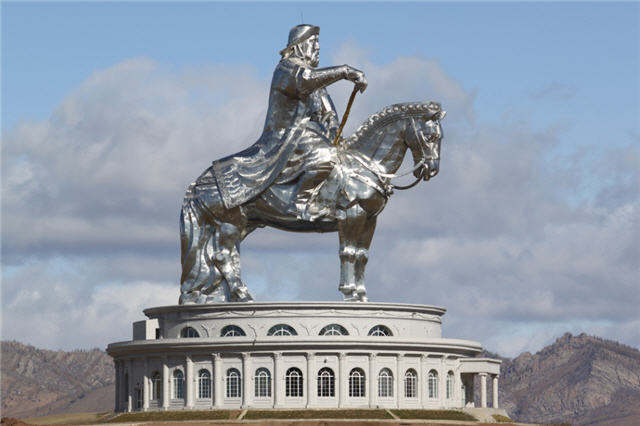The most successful conquerors in history do not begin their lives lusting for total domination. Genghis Khan's first military campaigns grew out of the need to rescue his kidnapped Mother and then to unite a scattered people in a common cause. The Agile framework was born out of the necessity for a better, more unified system of operation to improve the lives of every one involved. Leading Agile analysts state that 80% of all software development is conducted using Agile methods while organizations are moving into highly collaborative, team-based environments. Much like the golden horde of Genghis Khan, software developers who band together will conquer the world.
Winter has fallen on the steppes of Mongolia, and many of its inhabitants begin to quarrel with each other in the increasingly harsh conditions. A snake with many heads finds shelter, but one of the other heads believes it has found a better place, and proceeds to pull the other heads away from their destination. Another snake, this one with many tails and only one head travels swiftly into a hole and begins to prepare for winter. The many-headed snake freezes to death on the steppe.
This example from Mongolian folklore, told by Genghis Khan to the sons who would inherit the world's largest and most culturally and religiously free empire illustrates the laconic but introspective nature of the people. The more recent work around Agile bears an undeniable resemblance, to the Mongol nation circa 1200 A.D. The first of these similarities go to the deepest roots of each idea, to the very core. Just as Genghis Khan saw the need for a broad code of law, the Agile Manifesto provides the values and principles to discover agility without being prescriptive.
This importance of the core idea are what Agile and the Mongolian empire were built on, upholding the desire to create an organization in which the greatest amount of people can benefit from the work being done by all. This concordance lies in the team size and spirit of self-organization: where Agile teams typically consist no more than ten members, Genghis Khan's Persian-descended Decimal structure created “aravt,” or groups of ten. Each team benefits from being cross-functional in order to survive and progress with limited reliance on others.Genghis Khan had no need for bloodlines to determine the hierarchy of his empire, as Agile has little interest in titles and keeps influencing the traditional hierarchical reporting structure still found in many businesses today. This type of organization is often derided by the opposition stating that Agile can’t scale as the teams resemble nomadic tribes operating in complete chaos. For Genghis Khan the solution is found by structuring his entire organization into units of ten that increased tenfold every level, thereby providing concentric circles of command, ensuring swift action.Genghis Khan called these units aravt (10), zuut (100), myangat (1,000) and tumen (10,000). Through rigorous discipline Genghis Khan transformed these groups of fierce but unfocused warriors into the most highly collaborative fighting force the world had ever seen.Genghis Khan embodied agile leadership, as a servant leader, wanting only what would yield the greatest benefit for all. This unique trait was best captured by Geoffrey Chaucer describing him as a great and kind ruler of many talents in The Canterbury Tales where “He kept his law, to which that he was sworn”.
The reason these groups were able to be commanded with such great ease and precision resulted from a meeting (khurlitai) where the leaders across the organization conducted planning sessions that resulted into clear orders. These orders created one of the most fearsome attack patterns in history, the blitz pattern. As with blitz planning in Agile, the blitz attacks work in much the same way: quick and with a clearly defined purpose for action.These khurlitai created the most easily scalable force that could be mobilized at a moment's notice, and adapt to a wide variety of change. Even the largest groups of 10,000 men were very agile. This type of large scale agility mimics the ability in Agile to start and stop projects or development on a variable cost scale, thereby requiring less initial investment to gain ground much more quickly.After the Mongols swept through a province or country, merchant routes were created and fortified to make sure that goods could be brought back to their homeland in a safe and timely fashion. These roads acted as safe communication channels as well, further quickening the speed and clarity with which information could be disseminated throughout the empire.The Mongol army accomplished this by having one sensibility that all other groups lacked—to never return home on the same route. Similar to embracing a culture of continuous improvement in Agile, by improving the technology and knowledge of every citizen of the empire, the Mongols left behind an entire world of people with specialized skills, who could build cities as well as effectively govern them.Only by collaboration was the empire of Genghis Khan successful by any measure. Only by communication in the most open sense did they manage to keep the most diverse lands at peace, and bring the wonders of the modern world, to everyone in the modern world.To be truly agile is to succeed on all fronts, utilizing a group of people regardless of size to work towards a common goal that will enrich the lives of everyone involved.


